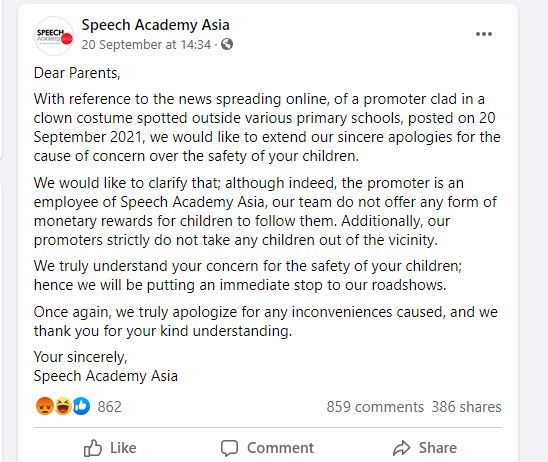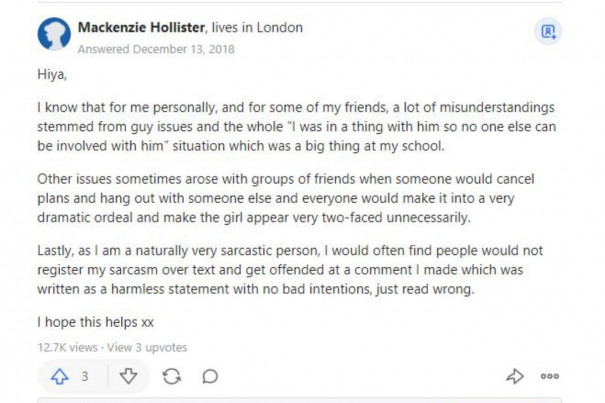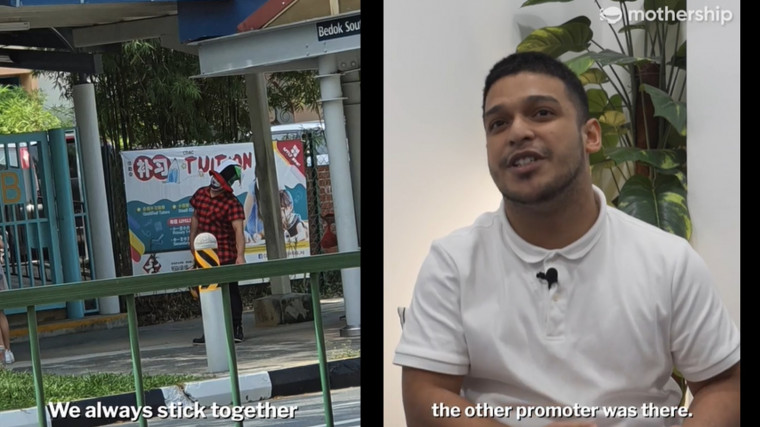|
Audio Version Available
|
A ripple of misunderstanding can result in a tsunami of problems.
Misunderstandings are the root of conflict in many relationships — be it between life partners, family, friends or even colleagues. A small mix-up can sometimes snowball into an avalanche of unpleasantness.
On Sept 20, parents went into a panic when a photo of a person dressed as a clown outside a school went viral. A school in the east also issued a letter of warning to parents about the incident. It garnered so much attention that even Speaker of Parliament Tan Chuan-Jin posted it on his social media.
As the news spread across social media, netizens began jumping to conclusions based on the limited information. Multiple police reports were made by horrified parents concerned about the safety of their children. Some even went so far as to speculate on Whatsapp chat groups — based on one photo and unverified allegations that the clown was luring children with money — that he had malicious intentions.
When strangers jump to conclusions

In a matter of hours, the police stepped in to investigate the situation and advised the public not to speculate while they were verifying what had happened.
That afternoon, enrichment centre Speech Academy Asia put up a post on its Facebook page admitting that the person dressed as a clown was one of its promoters.

The centre took ownership of the failed campaign and apologised for scaring the public.
On Monday (Sept 27), a week after the clown photo went viral, Mothership interviewed the enrichment centre owner and the promoter to hear their side of the story.
In the video, the 24-year-old promoter named Khairin, explained that the photo of him dressed as a clown made it seem as if he was ominously lurking at the bus-stop alone. In actuality, he said that he was with another promoter that was not in the picture.
He clarified that he wasn’t wearing any clown make-up, instead, he was just wearing a party hat and a mask decorated to look like a clown’s face.
Khairin said that when he found out that there were accusations of him attempting to bribe children with $1,000, he was shocked. He was working at another school when a parent told him the news. He stopped work immediately.
Said Khairin: “I cried in the taxi on the way back (to the company), and I hid in the store(room).”
Later on, he confessed that he dreaded reading the online comments but still felt compelled to do it. The harsh comments and assumptions by netizens really affected him, he added.
“I wondered why people were being so harsh,” he said.
View this post on Instagram
Viewers showed their support for Khairin in the comment section of the Mothership video, which has received more than 350,000 views since it was posted four days ago.
@a._.ydennn said: “This honestly goes to show we need to understand situations better before even making conclusions, you all were framing them as if they were serial killers.
@tame_kepala added : “I feel sorry for Khai, hope you are doing well bro. You are just doing your job, I respect the hustle. I also admire the company for their courage to acknowledge and apologise for the incident. Hopefully we can learn from this and move on”
This incident shows the dangers of jumping to conclusions and how a small misunderstanding can (in this case, exacerbated by overzealous parents) affect real people’s livelihood and mental well-being.
When couples break down

Simply put, misunderstanding comes from a lack of communication.
It occurs everywhere, at any time and in any circumstance — between strangers, colleagues, friends, family and even (some may say especially!) couples.
A 2016 study in Malaysia reported that misunderstanding is one of the leading causes of divorce among young couples, with 56.2% of men and 38% of women citing it as the main reason.
While infidelity has the potential to end a relationship abruptly, misunderstandings between partners is a slow destroyer — a little here today, another tomorrow, and some more the next day. If these small issues are not resolved, before you know it, it becomes a cascade of misunderstandings that make couples believe they are incompatible.
In Singapore, more couples are also calling it quits during the pandemic, citing lack of quality time, differing priorities and poor communication.
Ms Jean Chen, director and psychotherapist at private counselling practice Relationship Matters, explained that increased job worries and economic uncertainties, combined with a lack of assurance and positive emotional responses, is a recipe for romantic disasters.
She told the Straits Times: “Emotional responsiveness towards each other is very important. When there is a lack of care for hurt feelings in conversations, communication breakdowns happen.”
When friends fall out

Friends may not have the romantic baggage that couples do, but are also often victims of misunderstandings. Often, minor comments and trivial arguments lead to major falling outs. It’s worse when gossip undermines the strength of the friendship.
In secondary school, I experienced and saw fights breaking out from misunderstandings. Once, my friends got into a brawl after one accidentally kicked another while playing football. The victim thought it was done on purpose and that was enough to spark a fight.
I have seen friendship severed after a misunderstanding from both parties.
I remember when a friend of mine made a sarcastic joke to me about a mutual friend. Unknown to him, that friend overheard the conversation and assumed he was bad-mouthing him. He didn’t clarify and soon, he began distancing himself without explanation. As time went by, those two friends drifted apart and lost touch.
I’ve realised that these cases happen all over the world:

How do we avoid it?
One important thing to note is that avoiding misunderstandings is not the same as avoiding conflict.
Sometimes, conflict is inevitable because we have differing opinions. Conflict itself is not bad, it is how we resolve it that matters. But that’s a topic for another time!
So if the main cause of misunderstandings is a lack of communication, then the answer is simple: the solution is to communicate clearly.
Ensure that your intentions are clear. Too often, we say one thing but mean another, and expect people to “read between the lines” or understand the context without explanation.

Not everyone is sensitive to body language and verbal nuances. Even if they are, our backgrounds — race, culture, religion, upbringing — give us different perspectives. Take hand gestures for example, touching your thumb and index finger into an “okay” sign is okay… unless you’re in Brazil.
People often make completely different interpretations. Or they misconstrue our intentions. And this can result in all sorts of trouble.
Sometimes, we can’t help it. Sometimes, even when we make our intentions clear, it doesn’t get to the intended recipient correctly. Ever play the “Telephone Game”? You get the idea.
How then to resolve this? In this scenario, the way to avoid misunderstanding lies in the hands of the receiver.
Other stories you might like





In other words: Don’t jump to conclusions.
When we jump to conclusions, we reach a certain conclusion prematurely with insufficient information. For example, you might assume that someone you just met is angry at you, simply because that person wasn’t smiling while they spoke with you, even though there could be many alternative explanations for that behavior.
Jumping to conclusions is a natural thing. Our cognitive system relies on mental shortcuts (called heuristics), which increase the speed of our judgment and decision-making processes at the cost of accuracy.
That is useful in certain scenarios: When a man-eating tiger is charging at you, there’s a high chance that it’s not coming over to invite you to tea. But since we live in a more modern society where social interactions are more complex, we often need to take a step back and not take things at face value.
Before judging and taking action, get information from all parties and understand their different viewpoints. And where possible, err on the side of kindness.
Effective communication, sufficient information and giving people the benefit of the doubt are the keys to avoid misunderstandings. What you see may not be what you think.
As Khairin told Mothership: “I hope people don’t jump to conclusions. People just assume ‘oh that’s who I am’. Just find out more about the story first, then you can say what truly happened.”
If you like what you read, follow us on Twitter and Google News to get the latest updates.


